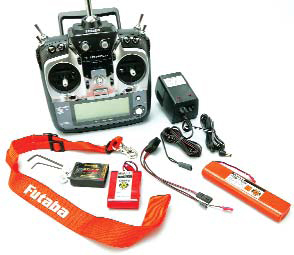|
Positioned neatly between Futabas sport radio line and its extreme high-end systems, the new 12FG is a full-tilt, top-end, no-holds-barred radio in a very refined package. Though missing some of the bling of the 12Z and 14MZ, you dont have to pay for anything that you might not really need. When youre flying, most important are all the little things that add up to a higher level of control over your prized model; there, this radio doesnt skimp on anything. If you want the best for less, look closely at Futabas new 12FG radio. FEATURES OK; so what makes this better than the typical 9-channel computer radio that most serious sport pilots use these days? Forget about the three extra channels. Maybe you fly simple 4-channel airplanes now, but that can change faster than you think. Maybe its the way the sticks feel. I dont think youll find anything better than the quad ball-bearing gimbals in the 12FG. Thats a big difference, as most radios have plastic or bronze bushings in this critical area. In addition to the super-smooth feel, you also have the ability to adjust the stick tension in each axis and throttle ratchet preload without opening the case. Most fixedwing pilots prefer a ratcheted throttle, but helicopter pilots need one without a ratchet, so this feature makes it a truly dual-purpose radio. You can enable or disable the throttle ratchet with a few twists of the included Allen key without disassembling the transmitter. |
|
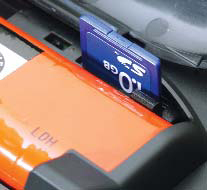 The Futaba 12FG incorporates internal flash The Futaba 12FG incorporates internal flashmemory for 30 model memories, and can store 1882 models with an optional 1GB SD memory card. |
The 12FG also benefits from Futabas PCM G3, previously only available with the high end 14MZ and 12Z systems. With 2048 resolution, PCM G3 transmits the slightest stick movements to the servos, giving the closest feel possible to actual realtime response for exacting speed and precision. The 12FG is also compatible with 1024PCM and PPM/FM receivers. If you fly at a crowded field, youll probably take advantage of the fact that the transmitter and receiver are frequency synthesized.You wont suffer waiting for pins and theres no crystal juggling either. You can change your channel in a few seconds using the Wireless Frequency Synthesizer technology that Futaba has developed for all of its high-end radios. Dont worry; this isnt something that you can accidentally do. While its not a complicated process, it does require deliberate effort on your part. Once you have it set up though it requires no further attention. The frequency assignment is saved with the model setup parameters and this transmitter has room for a lot of models! Thirty to be exact, and if thats not enough you can purchase an SD Flash card and store up to 1882 models. |
|
The programming screen is large and the contrast is easily adjustable, so you wont have a problem reading it under most lighting conditions, short of pure darkness. When you start to work through the model setup instructions in the manual, youll really begin to appreciate how easy this transmitter is to program. If youre familiar with computer radios, as I expect you are if youre seriously considering this radio, you may not even need to read the instructions for most setups. Most people will never use this radio to its full potential. Its that sophisticated. If you want to read through the manual and get a feel for all the capabilities of this remarkable radio, you can download themanual from the Great Planes website. Here are some of the things youll need to know right away so that you can get to the field. |
|
 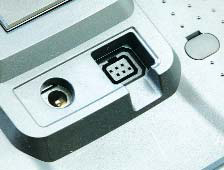 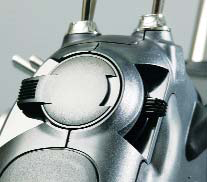 The Futaba 12FG incorporates internal flash memory for 30 model memories, and can store 1882 models with an optional 1GB SD memory card. The Futaba 12FG incorporates internal flash memory for 30 model memories, and can store 1882 models with an optional 1GB SD memory card. |
|
|
USING THE RADIO I usually fly with a neck strap, but this radio is so comfortable to hold that I had no problem just picking up the transmitter and flying with it in my hands. The rubber sections on the back of the case give you a good grip, and you can easily fly with your thumbs or by pinching the sticks as I do for precise control movements.If you just want to fly a simple 4-channel model, you can ignore most of the programming options for a moment. The default settings for a new model will get you pretty close. You must, of course, select the proper model type. Your options include aircraft, glider or helicopter types. Depending on what you fly, youll have a few more choices to make (wing or swashplate type) before you start to set up the first flight condition. Whats a flight condition? A flight condition is a model setup within a model setup, and you can set up to eight for each model. It allows you to adjust everything from trim settings to mixes and then activate these settings with a switch or a stick position. Why would you need that? In most cases, you dont. Typically, you will just set up a single condition for your model and head out to the field. On a complicated or sensitive model such as a turbine jet or a large aerobatic airplane, however, you will most certainly use this feature. If you fly pattern competition, you could set up a Normal condition for most of the sequence as well as Spin and Snap conditions. You may prefer to fly a large aerobat with different settings for takeoffs and landings, traditional aerobatics and 3D flying. Flight conditions let you tune the feel and your airplane for these specific flight situations. The possibilities are almost endless. Getting back to our simple 4-channel airplane: all you need to think about now are the servo directions and endpoint adjustments. These are easy to set up under the Linkage menu. Be advised that this radio uses different channel assignments than the ones typically found on Futaba sport radios. Certain channels are grouped to reduce any noticeable delay when you need to have more than one servo to control one control surface. This is common on large gas-powered models, helicopters and complex sailplanes. If youre setting up an existing model to work with your new 12FG transmitter, go into the Function item in the Linkage menu and reassign the channels so that the controls work properly on your model without your having to juggle the servo connections around. Hows that for flexibility? |
|
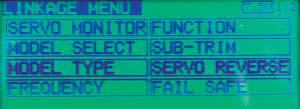 The Linkage menu is used for the initial set up of a new model. The Linkage menu is used for the initial set up of a new model. |
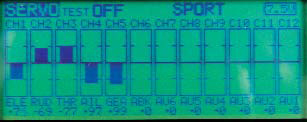 The Servo Monitor screen shows not only relative positions, but also percentages of travel for the flight condition you have selected.. The Servo Monitor screen shows not only relative positions, but also percentages of travel for the flight condition you have selected.. |
 You can set any channel within the 72Mhz band with a few simple key strokes. You can set any channel within the 72Mhz band with a few simple key strokes. |
 Individual functions can be mapped to any input you want. The channels are sequenced to minimize any mixing latency. Individual functions can be mapped to any input you want. The channels are sequenced to minimize any mixing latency. |
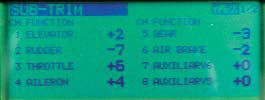 Sub trims are easily set on two screens, so you can see multiple offsets at once. Sub trims are easily set on two screens, so you can see multiple offsets at once. |
 Each model can have eight individual flight conditions assigned different names and switches. Each model can have eight individual flight conditions assigned different names and switches. |
|
SPECSSTREET PRICE: $999.99 FUTABA 12FG TRANSMITTER CHANNELS: 12 MODEL MEMORIES: 30 built in (up to 1,882 with SD memory card) MODEL TYPES: Aircraft, glider, helicopter BATTERY: 7.2V 1700mAh NiMH WEIGHT: 37.3 oz. with battery CURRENT DRAIN: 500mA (average) FUTABA R5114 DPS RECEIVER WEIGHT: 1.15 oz.
INCLUDES
|
|
|
SUMMARY A bargain at twice the price? Maybe so, but you wont have to pay that much to get one of Futabas new high-end systems. It includes the stylish 12FG transmitter along with Futabas revolutionary R5114 DPS G3 2048 PCM/WFSS (frequency synthesized) receiver. With the retirement of Futabas venerable 9Z WC2 systems, there was a need for another high-end system. The 12Z filled that void nicely but also created a wide gap between the 9-channel super sport systems and the 12Z. Enter the 12FG—a reasonably priced 12-channel system for serious sport modelers and budget-minded competition pilots. MIXING Once you have all of the controls set up, you can explore some of the mixing options. There are a few preconfigured mixes that you can use to correct for, shall we say, less than perfect airframe design traits. The most common are rudder to aileron (to correct roll coupling) and rudder to elevator (to correct pitch coupling). Lets face it: sometimes, you just cant get the airplane to trim out perfectly in every attitude. Since we cant go around cutting wings apart and lopping off pieces of the vertical fin and rudder, we can do the next best thing: fix with a mix is a viable solution unless youre an incurable purist. If you find that you need to create a special mix of your own, then have at it. This radio can do it. You have the option of creating up to 10 custom mixes per condition. You can activate them with your choice of a switch, a slider, or a stick position. You also have the capability to fine-tune most of the mixes with a rotary dial. This is really nice. Imagine if youre trying to set up your aileron differential so that you can fly perfect axial rolls. This is usually done by making an educated guess at the initial setup. Next, you fly the plane and observe the results. If you need to make further adjustments, you have to land the plane and play with the mix again, repeating as necessary until you are satisfied. With the 12FG, you can assign one of the easily accessible rotary dials as the fine tuning control. Having set this up, you just take off, pull vertical and start your roll. If the tail wags, turn the knob until it stops. After youve landed, you can apply the fine-tuning value to your mix and disable the fine tuning control. Done. You also have exponential and triple rates at your disposal, since most of the switches are three-position toggles. The rates can be linear or exponential or a combination of both. Additionally, you can set up different rates for each flight condition. Uh-oh; now we dont have an excuse for not being able to fly smooth, graceful maneuvers. There are so many great features that its hard to describe everything here. Ive concentrated mostly on aircraft-specific features, but there is one really neat helicopter thing that Ill mention. How many of you use a cyclic ring to limit your servos travel when you set up an aggressive 3D machine? What a crude but effective device that is. The 12FG has something called a swash ring function that provides the same effect as a cyclic ring but with the flexibility that can only come with digital programming. Your flying buddies will be impressed by this one, for sure. |
|
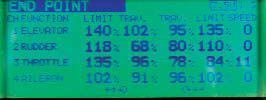 The End Point screen also lets you set the travel rate, slowing a servo for realistic motion, or to accommodate an engines transition characteristics. The End Point screen also lets you set the travel rate, slowing a servo for realistic motion, or to accommodate an engines transition characteristics. |
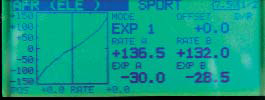 AFR (dual rates) can be set in 0.5-percent increments, assigned to specific switches, and combined with custom expo response curves. AFR (dual rates) can be set in 0.5-percent increments, assigned to specific switches, and combined with custom expo response curves. |
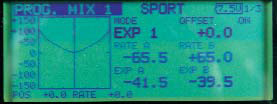 Preset and custom mixes can combine any two channels in any manner you might need or imagine. If your model needs this much rudder/elevator mixing, try a new design! Preset and custom mixes can combine any two channels in any manner you might need or imagine. If your model needs this much rudder/elevator mixing, try a new design! |
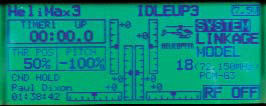 The helicopter home screen displays Throttle and Pitch position and Condition Hold operation. The transmitter is set to ch. #18, but not broadcasting. The helicopter home screen displays Throttle and Pitch position and Condition Hold operation. The transmitter is set to ch. #18, but not broadcasting. |
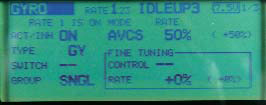 Gyro sensitivity and mode switching can be set for each flight condition. Gyro sensitivity and mode switching can be set for each flight condition. |
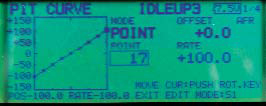 Helicopter pitch and throttle curves incorporate 17 points for maximum flexibility. Helicopter pitch and throttle curves incorporate 17 points for maximum flexibility. |
|
COMPATABILITY The charging jack on the back of the transmitter is not the standard coaxial plug supplied with Futabas Legacy systems; in fact, its quite a bit smaller. The high capacity 1700mAh NiMH battery is 7.2 volts instead of the more typical 9.6V transmitter pack, so this difference will prevent you from using the wrong charger. The battery is easy to remove and has a standard Futaba J connector, so you can still fast-charge it if you want to. You may recall that the old Berg receivers had problems understanding the unique signature of a Futaba 9Z transmitter equipped with a synthesized RF module. These receivers are quite happy with the 12FG transmitter operating in standard FM/PPM mode. This is good news for me because its almost indoor season here in the Northeast, and I cant wait to show off my new transmitter! I cant see how anyone could outgrow this radio. The G3 PCM offers super-precise control, you can use all your existing 1024 PCM and FM/PPM receivers, and the modular RF deck lets you use Futabas 2.4GHz module. Dont forget that you also have the support of Futabas excellent customer service to keep your radio in top condition for years to come. CONCLUSION Even when youre on a budget, you can treat yourself to something really nice once in a while. Wh en you think of how much money you spend on your models, doesnt it make sense to invest in one of the best control systems available today? Futaba has done a great job of making this radio one of the best values in its class. Then again, it may be in a class by itself. If youve decided to clean up your radio pool by using one transmitter for all of your models, the new Futaba 12FG should be your choice.Links Futaba, distributed exclusively by Great Planes Model Distributors www.futaba-rc.com (800) 682-8948 |
|
 Fly RC Magazine WE LIVE RC
Fly RC Magazine WE LIVE RC

